GMC SAVANA 1996 Manual Online
Manufacturer: GMC, Model Year: 1996, Model line: SAVANA, Model: GMC SAVANA 1996Pages: 372, PDF Size: 18.81 MB
Page 81 of 372
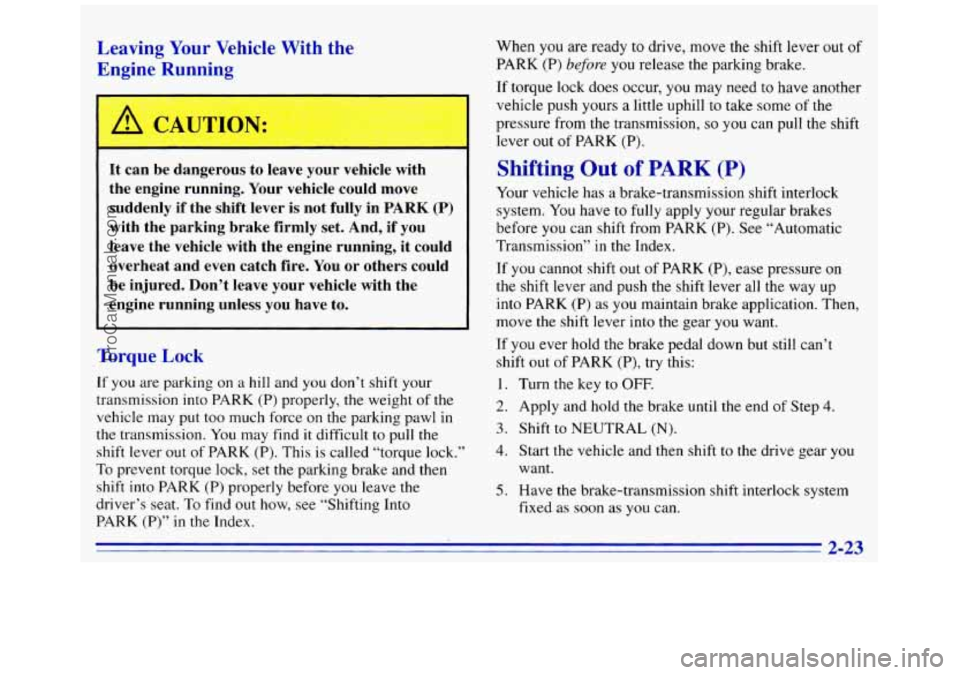
Leaving Your Vehicle With the
Enf;?e Rurr-;-y
It can be dangerous to leave your vehicle with
the engine running. Your vehicle could move
suddenly if the shift lever is not fully in PARK (P)
with the parking brake firmly set. And, if
you
leave the vehicle with the engine running, it could
overheat and even catch fire. You or others could
be injured. Don’t leave your vehicle with the
engine running unless you have to.
Torque Lock
If you are parking on a hill and you don’t shift your
transmission into PARK (P) properly,
the weight of the
vehicle may put too much force
on the parking pawl in
the transmission. You may find it difficult to pull the
shift lever out
of PARK (P). This is called “torque lock.”
To prevent torque lock, set the parking brake and then
shift into PARK (P) properly before
you leave the
driver’s seat. To find out how, see “Shifting Into
PARK
(P)” in the Index. When
you are ready
to drive, move the shift lever out of
PARK (P) before you release the parking brake.
If torque lock does occur, you may need
to have another
vehicle push yours a little uphill
to take some of the
pressure from the transmission,
so you can pull the shift
lever out of PARK
(P).
Shifting Out of PARK (P)
Your vehicle has a brake-transmission shift interlock
system.
You have to fully apply your regular brakes
before
you can shift from PARK (P). See “Automatic
Transmission” in the Index.
If
you cannot shift out of PARK (P), ease pressure on
the shift lever and push the shift lever all the way up
into PARK
(P) as you maintain brake application. Then,
move the shift lever into the gear you want.
If
you ever hold the brake pedal down but still can’t
shift out of PARK (P), try this:
1. Turn the key to OFF.
2. Apply and hold the brake until the end of Step 4.
3. Shift to NEUTRAL (N).
4. Start the vehicle and then shift to the drive gear you
5. Have the brake-transmission shift interlock system
want.
fixed
as soon
as you can.
2-23
ProCarManuals.com
Page 82 of 372
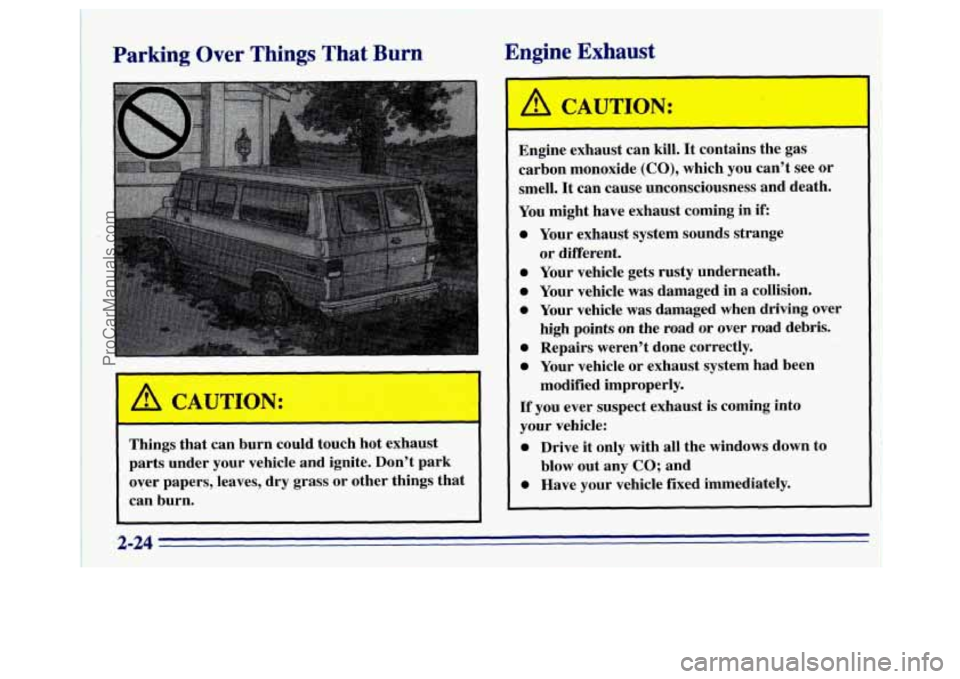
Parking Over Things That Burn
I
Things that can burn could touch hot exhaust
parts under your vehicle and ignite. Don’t park
over papers, leaves, dry grass
or other things that
can burn.
Engine Exhaust
Engine exhaust can kill. It contains the gas
carbon monoxide
(CO), which you can’t see or
smell. It can cause unconsciousness and death.
You might have exhaust coming in if:
0 Your exhaust system sounds strange
0 Your vehicle gets rusty underneath.
0 Your vehicle was damaged in a collision.
0 Your vehicle was damaged when driving over
high points on the road or over road debris.
0 Repairs weren? done correctly.
0 Your vehicle or exhaust system had been
If you ever suspect exhaust is coming into
your vehicle:
0 Drive it only with all the windows down to
0 Have your vehicle fixed immediately.
or
different.
modified improperly. blow out any
CO; and
I
I ’,
2-24 - --
ProCarManuals.com
Page 83 of 372
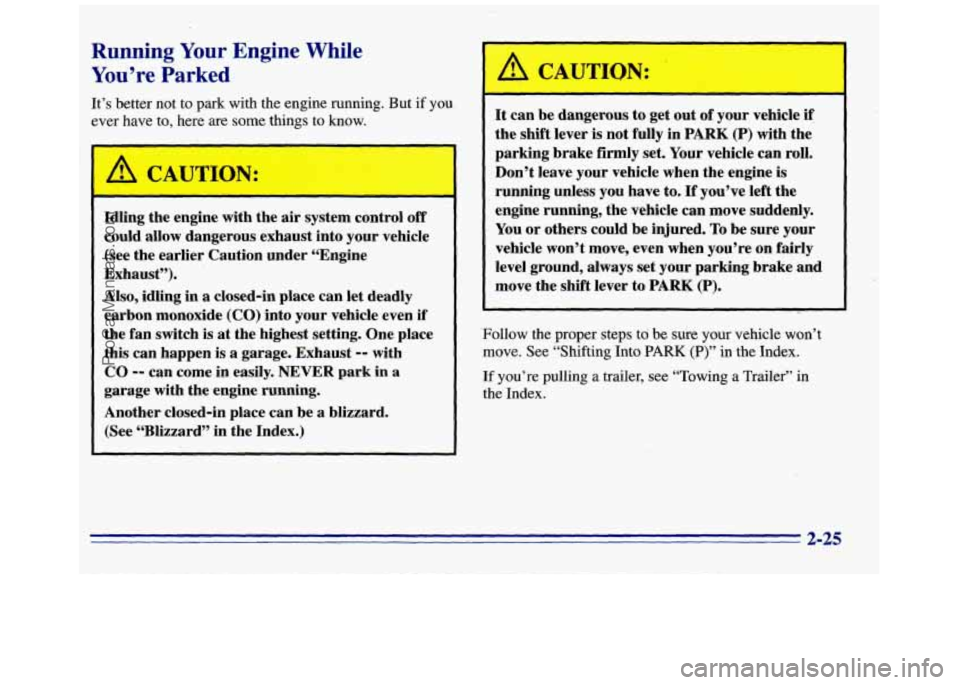
Running Your Engine While
You’re Parked
It’s better not to park with the engine running. But if you
ever have to, here are some things to know.
I
CAUTION:
Idling the engine with the air system control off
could allow dangerous exhaust into your vehicle
(see the earlier Caution under “Engine
Exhaust”).
Also, idling in a closed-in place can let deadly
carbon monoxide (CO) into your vehicle even if
the fan switch is at the highest setting. One place
tkiis can happen is a garage. Exhaust
-- with
CO
-- can come in easily. NEVER park in a
garage with the engine running.
Another closed-in place can be
a blizzard.
(See “Blizzard” in the Index.)
A CAUTION: .-
It can be dangerous to get out .of your vehicle if
the shift lever
is not fully in PARK (P) with the
parking brake
firmly set. Your vehicle can roll.
Don’t leave your vehicle when the engine is
running unless you have to.
If you’ve left the
engine running, the vehicle can move suddenly.
You or others could be injured.
To be sure your
vehicle won’t move, even when you’re on fairly
level ground, always set your parking brake and
move the shift lever to PARK
(P).
.
’Follow the proper steps td be sure your vehicle won’t
move. See “Shifting Into
PARK (P)” in the Index.
If you”re pulling a, trailer, see “Towing a Trailer” in
the Index.
2-25
ProCarManuals.com
Page 84 of 372
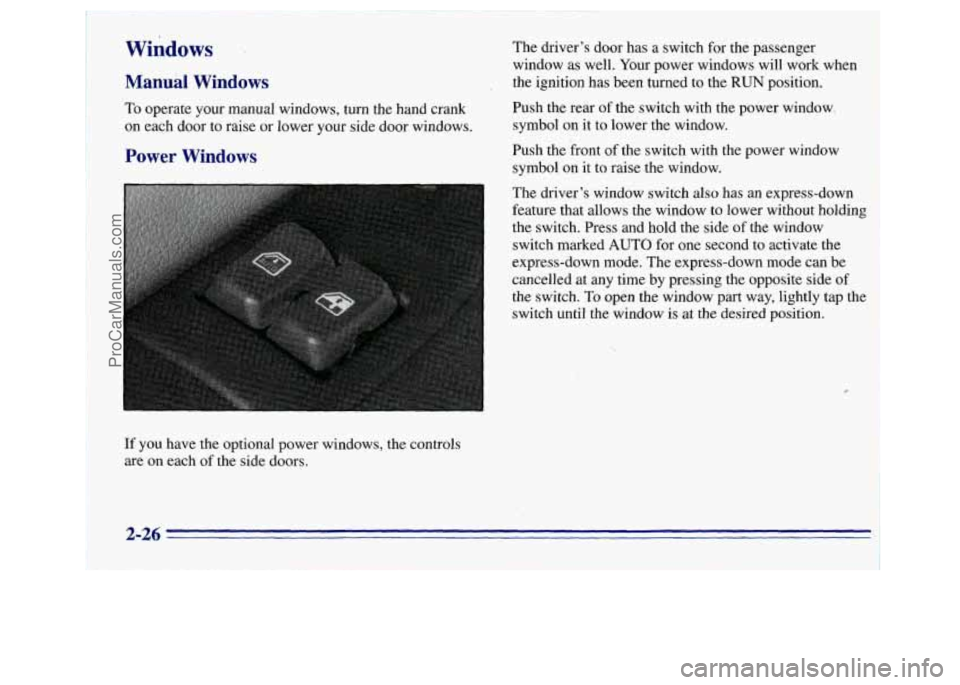
Windows
Manual Windows
To operate your manual windows, turn the hand crank
on each door to raise or lower your side door windows.
Power Windows
The driver’s door has a switch for the passenger
window as well. Your power windows will work when
the ignition has been turned to the
RUN position.
Push the rear
of the switch with the power window,
symbol on it to lower the window.
Push the front
of the switch with the power window
symbol on it
ta raise the window.
The driver’s window switch also has an express-down
feature that allows the window to lower without holding
the switch. Press and hold the side
of the window
switch marked
AUTO for one second to activate the
express-down mode. The express-down mode can be
cancelled at any time by pressing the opposite side
of
the switch. To open the window part way, lightly tap the
switch until the window is at the desired position.
If you have the optional power windows, the controls
are
on each of the side doors.
2-26 1
ProCarManuals.com
Page 85 of 372
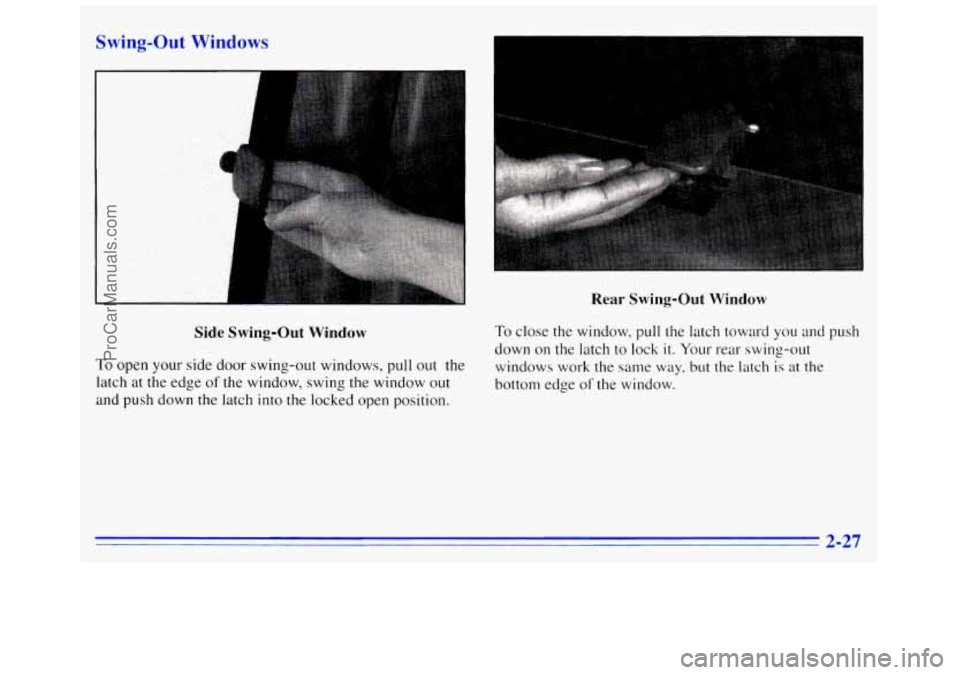
Swing-Out Wini ws
I
I
Side Swing-Out Window
To open your side door swing-out windows, pull out the
latch at the edge
of the window, swing the window out
and push down the latch into the locked open position.
Rear Swing-Out Window
To close the window, pull the latch toward you and push
down
on the latch to lock it. Your rear swing-out
windows work the same way, but the
latch is at the
bottom edge of the window.
2-27
ProCarManuals.com
Page 86 of 372
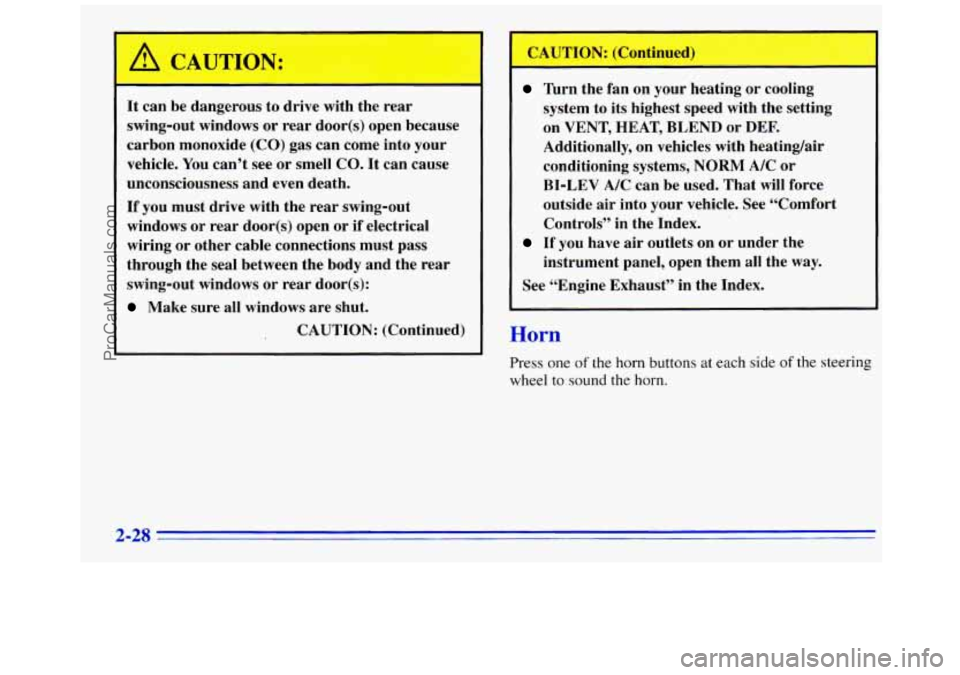
-
It can be dangerous to drive with the rear
swing-out windows or rear door@) open because
carbon monoxide (CO) gas can come into your
vehicle. You can’t see or smell CO. It can cause
unconsciousness and even death.
If you must drive with the rear swing-out
windows or rear door@) open or if electrical
wiring or other cable connections must pass
through the seal between the body and the rear
swing-out windows or rear door(s):
Make sure all windows are shut.
CAUTION: (Continued)
Turn the fan on your heating or cooling
system to its highest speed with the setting
on VENT, HEAT, BLEND or
DEF.
Additionally, on vehicles with heatingair
conditioning systems, NORM A/C or
BI-LEV
A/C can be used. That will force
outside air into your vehicle. See “Comfort
Controls’’ in the Index.
instrument panel, open them all the way.
If you have air outlets on or under the
See “Engine Exhaust” in the Index.
Horn
Press one of the horn buttons at each side of the steering
wheel to sound the horn.
2-28
ProCarManuals.com
Page 87 of 372
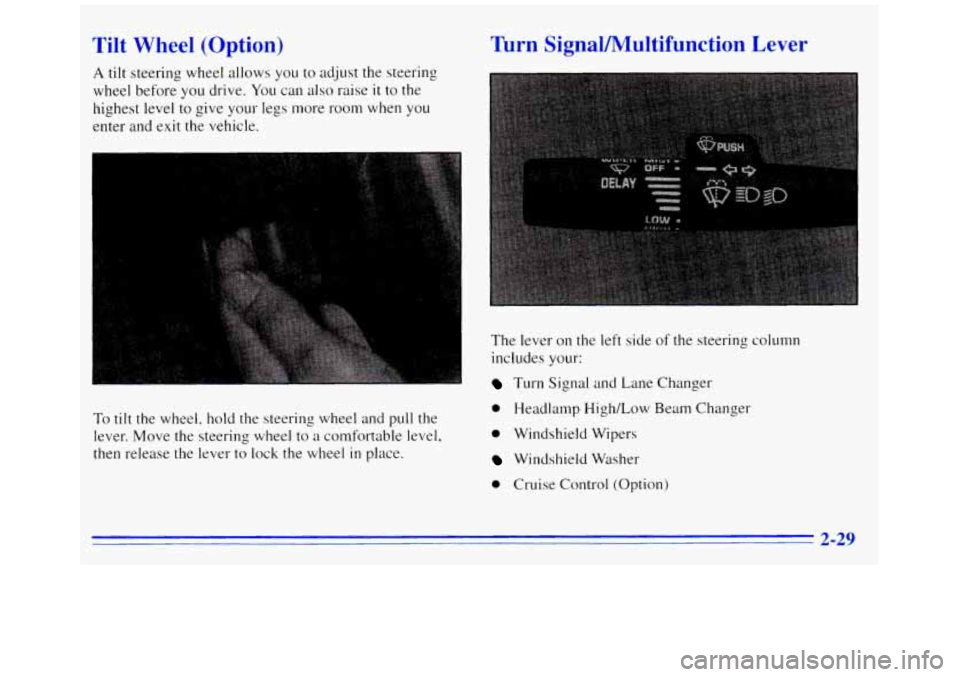
Tilt Wheel (Option) Turn SignaVMultifunc on Lever
A tilt
steering wheel allows you to adjust the steering
wheel before you drive. You can
also raise it to the
highest level to give your legs more room when you
enter and exit the vehicle.
The lever on the left side of the steering column
includes your:
To tilt the wheel, hold the steering wheel and pull the
lever. Move the steering wheel
to a comfortable level,
then release the lever
to lock the wheel in place.
Turn Signal and Lane Changer
0 Headlamp High/Low Beam Changer
0 Windshield Wipers
Windshield Washer
0 Cruise Control (Option)
2-29
ProCarManuals.com
Page 88 of 372
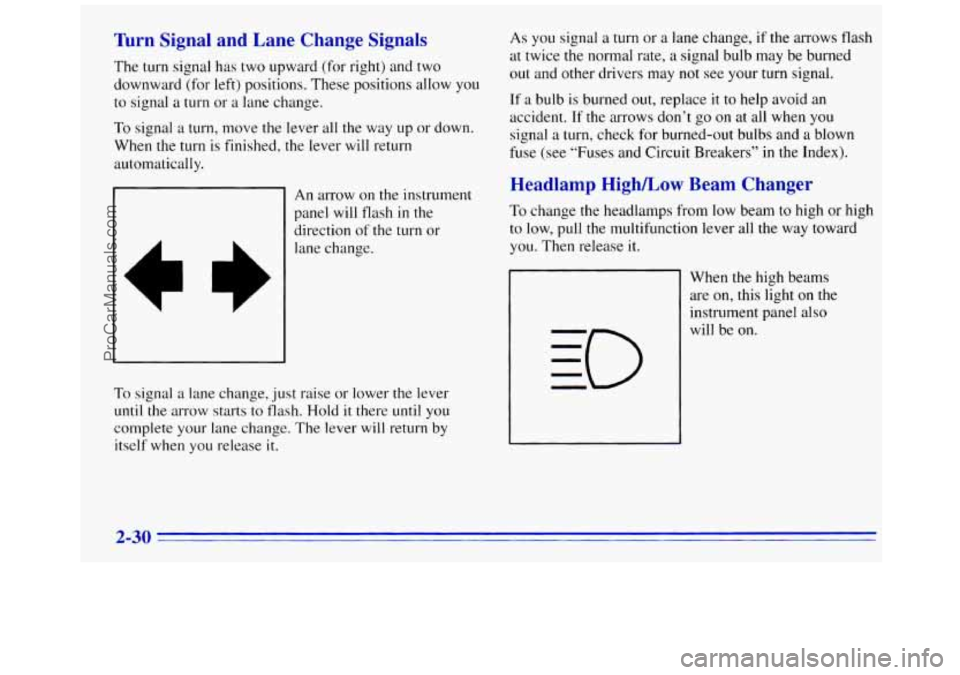
Turn Signal and Lane Change Signals
The turn signal has two upward (for right) and two
downward (for left) positions. These positions allow you
to signal
a turn or a lane change.
To signal a turn, move the lever all the way up or down.
When the
turn is finished, the lever will return
automatically.
An arrow on the instrument
panel will flash
in the
direction
of the turn or
lane change. As you
signal a turn or a lane change, if the arrows flash
at twice the normal rate, a signal bulb may be burned
out and other drivers may
not see your turn signal.
If a bulb is burned out, replace it to help avoid an
accident.
If the arrows don’t go on at all when you
signal a turn, check for burned-out bulbs and a blown
fuse (see “Fuses and Circuit Breakers” in
the Index).
Headlamp High/Low Beam Changer
To change the headlamps from low beam to high or high
to low, pull the multifunction lever
all the way toward
you. Then release
it.
To signal a lane change, just raise or lower the lever
until the arrow starts to flash. Hold it there until you
complete your lane change. The lever will return
by
itself when you release it.
When the high beams
are
on, this light on the
instrument panel also
will be on.
2-30
ProCarManuals.com
Page 89 of 372
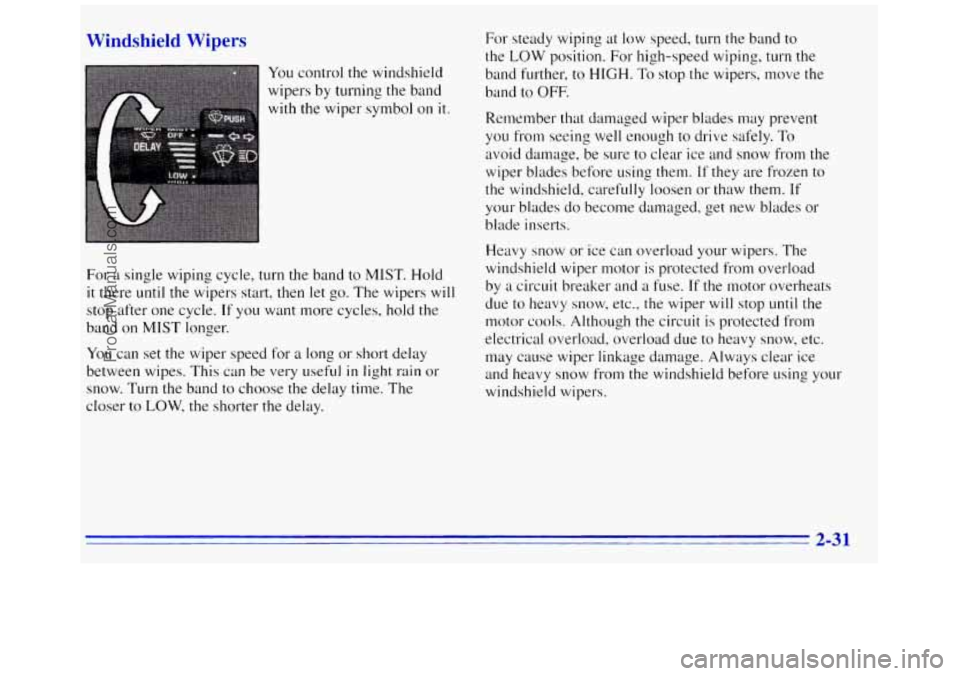
Windshield Wi
You control the windshield
wipers by turning the band
with the wiper symbol on
it.
For a single wiping cycle, turn the band to MIST. Hold
it there until the wipers start, then let go. The wipers will
stop after one cycle.
If you want more cycles, hold the
band on MIST longer.
You can set the wiper speed for a long or short delay
between wipes. This can
be very useful in light rain or
snow. Turn the band to choose the delay time. The
closer to
LOW, the shorter the delay. For steady wiping
at low speed,
turn the band to
the
LOW position. For high-speed wiping, turn the
band further,
to HIGH. To stop the wipers, move the
band to
OFF.
Remember that damaged wiper blades may prevent
you from seeing well enough
to drive safely. To
avoid damage, be sure to clear ice and snow from the
wiper blades before using them.
If they are frozen to
the windshield, carefully loosen or thaw them.
If
your blades do become damaged, get new blades or
blade inserts.
Heavy snow or ice can overload your wipers. The
windshield wiper motor
is protected from overload
by a circuit breaker and a fuse. If the motor overheats
due
to heavy snow, etc., the wiper will stop until the
motor cools. Although the circuit is protected from
electrical overload, overload due
to heavy snow, etc.
may cause wiper linkage damage. Always clear ice
and heavy snow from the windshield before using your
windshield wipers.
2-31
ProCarManuals.com
Page 90 of 372
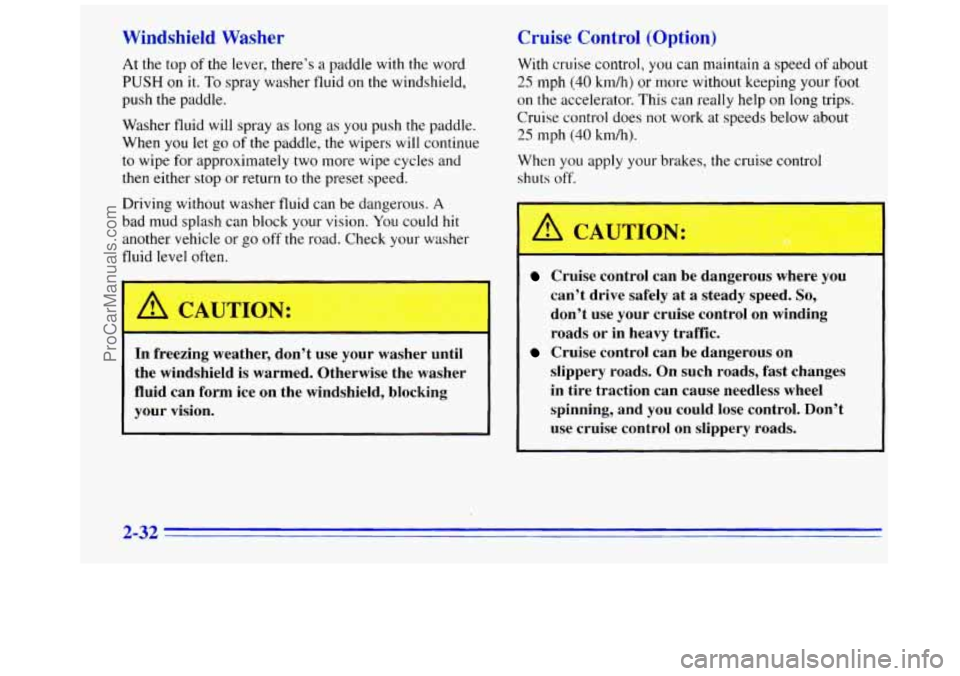
Windshield Washer
At the top of the lever, there’s a paddle with the word
PUSH on it. To spray washer fluid on the windshield,
push the paddle.
Washer fluid will spray as long
as you push the paddle.
When
you let go of the paddle, the wipers will continue
to wipe for approximately two more wipe cycles and
then either stop or return to the preset speed.
Driving without washer fluid can be dangerous.
A
bad mud splash can block your vision. You could hit
another vehicle or
go off the road. Check your washer
fluid level
often.
Cruise Control (Option)
With cruise control, you can maintain a speed of about
25 mph (40 km/h) or more without keeping your foot
on
the accelerator. This can really help on long trips.
Cruise control does not work at speeds below about
25 mph (40 km/h).
When you apply your brakes, the cruise control
shuts off.
In freezing weather, don’t use your washer until
the windshield
is warmed. Otherwise the washer
fluid can form ice on the windshield, blocking
your vision.
Cruise control can be dangerous where you
can’t drive safely at a steady speed.
So,
don’t use your cruise control on winding.
roads or in heavy traffic.
slippery roads. On such roads, fast changes in tire traction can cause needless wheel
spinning, and you could lose control. Don’t
use cruise control on slippery roads.
Cruise control can be dangerous on
2-32
ProCarManuals.com